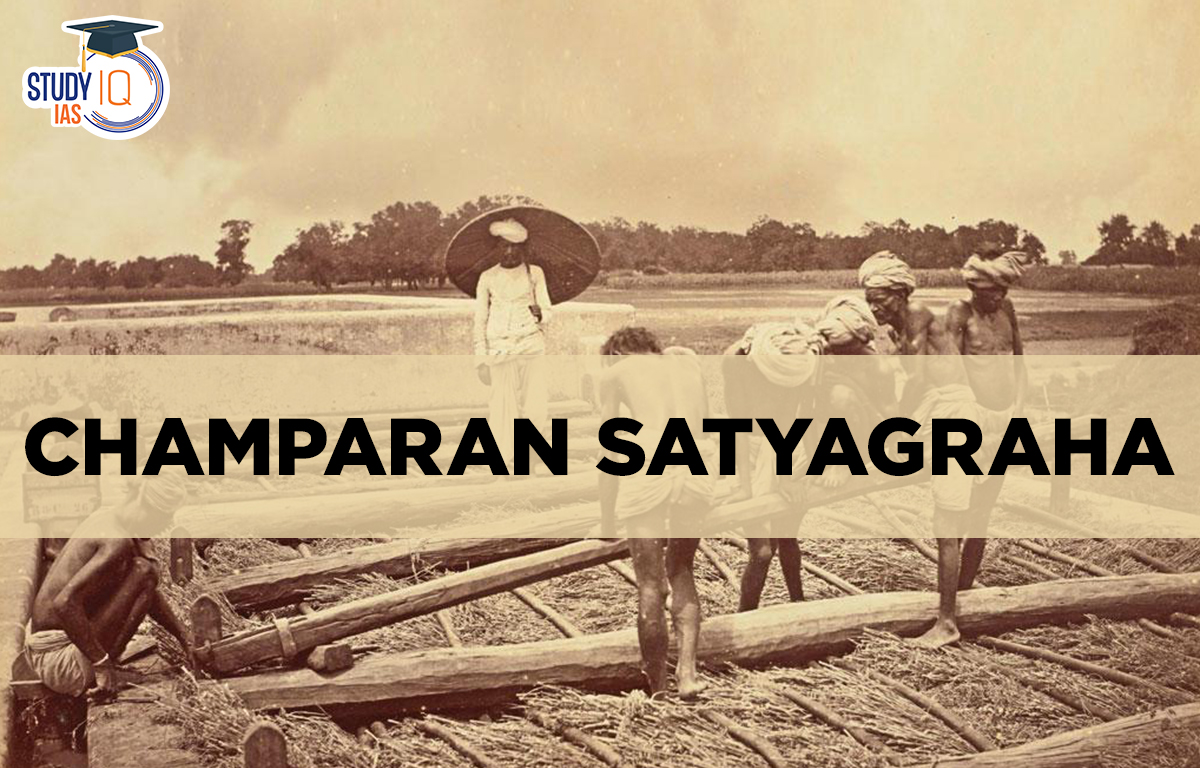Table of Contents
The Champaran Satyagraha, led by Mahatma Gandhi in 1917, was a pivotal moment in India’s struggle for independence. Initiated in the Champaran district of Bihar, the movement protested against the exploitative indigo plantation system imposed by British landlords. Check Out Details on Champaran Satyagraha in this article.
Champaran Satyagraha 1917
Champaran Satyagraha in 1917 was India’s first organised act of civil disobedience. The East Champaran district and the West Champaran district make up the historic Champaran district in Bihar, India. In 1914 and 1916, farmers in this area rose up in rebellion against the British because of the restrictions placed on the cultivation of indigo.
Similar circumstances existed in Bengal earlier, but after a significant revolt in 1859–1861, the peasants there gained their independence from the indigo planters. The characteristics of Champaran Satyagraha shall be covered in this article in order to aid with UPSC test preparation.
| Details | |
|---|---|
| Date | April 10, 1917, to April 18, 1917 |
| Location | Champaran district, Bihar, India |
| Initiator | Mahatma Gandhi |
| Cause | Agitation against indigo plantation and forced indigo cultivation imposed by British landlords |
| Key Participants | Mahatma Gandhi, Raj Kumar Shukla, Mazharul Haque, etc. |
| Objectives |
|
| Methods | Non-violent civil disobedience, Satyagraha (truth force) |
| Outcome |
|
| Significance |
|
What is India’s First Satyagraha?
The first Satyagraha movement led by Mahatma Gandhi in India was the Champaran Satyagraha of 1917. It was a farmer’s uprising in the Champaran district of Bihar during the British colonial period. The Champaran Satyagraha is considered a historically important revolt in the Indian Independence Movement. The Champaran Satyagraha was a revolt against the British indigo policy. The demand for indigo dropped when the Germans invented a cheaper artificial dye. However, during the First World War the German dye ceased to be available and indigo once more became profitable for the British. Many tenants were forced again into indigo cultivation.
Champaran Satyagraha History
Champaran, a district in Bihar, India, was known for its indigo plantations. The British colonial administration had imposed a system known as Tinkathia, which forced Indian peasants to cultivate indigo on a portion of their land, regardless of its suitability for other crops. This system led to the exploitation and oppression of the peasants by European indigo planters.
- Peasants’ Plight: The peasants in Champaran faced various injustices, including forced cultivation, arbitrary fines, and poor living conditions. Many were subjected to harsh treatment and economic exploitation by the British planters.
- Gandhi’s Involvement: In 1917, Mahatma Gandhi, who had recently returned to India from South Africa, visited Champaran at the request of local farmers. Despite being initially hesitant to involve himself in Indian domestic issues, Gandhi was deeply moved by the plight of the Champaran peasants and decided to take up their cause.
- Survey and Investigation: Gandhi conducted a thorough survey and investigation into the grievances of the Champaran peasants. He visited villages, spoke to the farmers, and gathered evidence of the injustices they faced under the Tinkathia system.
- Legal Battle: Armed with evidence and support from the local community, Gandhi challenged the British authorities and the indigo planters through legal means. He demanded the abolition of the Tinkathia system and sought justice for the oppressed peasants.
- Civil Disobedience: Despite facing resistance and threats of arrest from the British officials, Gandhi remained steadfast in his commitment to nonviolent resistance. He encouraged the peasants to refuse to pay taxes and to peacefully disobey unjust laws.
- Satyagraha in Action: Gandhi’s approach of nonviolent resistance, known as satyagraha, was put into action in Champaran. He urged the peasants to stand up for their rights with courage and dignity, setting an example of passive resistance against oppression.
Champaran Satyagraha Features
The Champaran Satyagraha was a remarkable episode in India’s struggle for independence, characterized by several distinctive features:
| Feature | Description |
|---|---|
| Nonviolent Resistance (Satyagraha) | Gandhi introduced the concept of satyagraha, advocating nonviolent resistance against oppressive British policies. |
| Focus on Rural Issues | Highlighted grievances of rural peasants, particularly indigo farmers in Champaran, bringing attention to exploitation in rural communities. |
| Documentation and Evidence Gathering | Emphasized the importance of gathering evidence to support peasants’ claims against indigo planters and British authorities. |
| Legal Strategy | Advocated for the abolition of the Tinkathia system through legal means while mobilizing public opinion through nonviolent resistance. |
| Community Participation | Actively involved local community, empowering peasants to collectively resist oppression and assert their rights. |
| International Attention | Attracted significant international attention and support, highlighting the global significance of the Indian freedom struggle. |
| Resolution through Dialogue | Despite its confrontational nature, remained open to dialogue and negotiation with British authorities, leading to eventual resolution through the appointment of a committee. |
| Inspiration for Future Movements | Inspired similar movements across India and influenced the trajectory of the Indian independence movement. |
Champaran Satyagraha Indigo Rebellion
In 1917, there was a farmer uprising known as the Champaran Satyagraha. The farmers objected to the forced growth of indigo, a lucrative crop that required meticulous attention and depleted the soil’s nutrients. The Bengali Indigo Rebellion, which took place in 1860, served as inspiration for the uprising. A natural blue dye with a sizable market abroad existed called indigo, which the Europeans monopolised at the expense of India’s impoverished farmers.
Even though it was draining the farmers to the bone, there was a lot of pressure on them to plant indigo. They struggled to break even on the cost of its cultivation because there were no profits and high rents and taxes. Numerous attorneys emphasized the numerous examples of illegal extortion tactics used by the landlords. Peer Muneesh and Ganesh Shankar Vidyarthi are two among them.
Mahatma Gandhi was brought to Champaran in 1917 thanks to the efforts of Raj Kumar Shukla and Sant Raut. The Indian legal community actively participated in this effort. Gandhi founded India’s first elementary school in a little town called Barharwa Lakhansen, 30 kilometres from East Champaran.
On November 13th, 1917, he organised a group of knowledgeable attorneys to conduct an extensive assessment of the town to determine the subpar standard of living that the locals were forced to endure. Rajendra Prasad, Anugrah Narayan Sinha, and Babu Brajkishore Prasad were among the attorneys on this team. On April 16, 1917, Mahatma Gandhi was detained on suspicion of inciting a riot and was given the order to leave the country.
He firmly refused to pay the Rs. 100 fee when it was demanded. Thousands of people protested his arrest, and the court had released him. Later, the case was returned as well. Under Gandhi’s direction, organised strikes were conducted against the landlords. During this uprising, he heard the names “Bapu” and “Mahatma” for the first time ever.
Champaran Satyagraha Significance
- The Champaran Agrarian Act of 1918 was established to counter the oppressive practices of planters over peasants, marked by forced cultivation and poor harvests.
- Gandhi, initially not actively involved in grassroots activism in India, gained attention due to the success of the Champaran initiative in restoring justice.
- Rajendra Prasad, later a key figure in Gandhi’s movement, along with other influential individuals like Kriplani, joined Gandhi’s team.
- Gandhi collected evidence from oppressed peasants to bolster his arguments, highlighting the effectiveness of data-driven approaches in challenging British policies.
- Despite being ordered to leave Champaran upon arrival, Gandhi chose civil disobedience, stating his preference for arrest over abandoning his mission.
- This marked a pivotal moment for satyagraha, demonstrating its potential to combat injustice and laying the groundwork for subsequent struggles that ultimately led to India’s independence.
Champaran Satyagraha Outcome
-
Champaran Agrarian Bill: The Champaran Agrarian Bill was passed in 1918, which protected the interests of peasants and provided relief to indigo cultivators and land tenants. The bill was based on almost all of the recommendations made by Gandhi’s mission.
-
Nonviolent resistance: The Champaran Satyagraha was a significant victory for indigo farmers and boosted Gandhi’s reputation as a leader of nonviolent resistance. Satyagraha became a novel method that Gandhi would use successfully in the Indian Independence movement.
-
Government action: The British authorities appointed the Champaran Agrarian Committee to investigate the farmers’ concerns, which led to the passing of the Champaran Agrarian Bill. The government also appointed a commission to investigate the cultivators’ claims, and Gandhi served on the committee.
-
Educational and economic conditions: Gandhi established voluntary groups to improve the people’s economic and educational conditions, such as building schools and educating people on sanitation.
Champaran Satyagraha UPSC
Gandhi’s victory in Champaran elevated him to a position of prominence with the populace and the existing leadership, who had already admired him for his efforts in South Africa. This gave him the opportunity to lead the campaign until it was successful.


 Ramakrishna Mission, History, Objective,...
Ramakrishna Mission, History, Objective,...
 Swami Vivekananda Biography, Early Life,...
Swami Vivekananda Biography, Early Life,...
 Rivers of India List with Map, From Gang...
Rivers of India List with Map, From Gang...




















